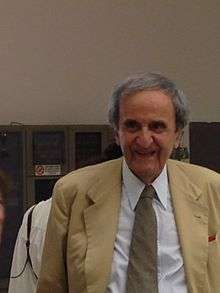Tomás Maldonado
| Tomás Maldonado | |
|---|---|
 Maldonado in Milan in 2014 | |
| Born |
25 April 1922 Buenos Aires, Argentina |
| Nationality | Argentinian |
| Occupation |
Painter Philosopher Industrial designer |
| Years active | 1954-present |
| Known for | Ulm Model |
Tomás Maldonado (born 25 April 1922) is an Argentine painter, designer and thinker, considered one of the main theorists of design theory of the legendary Ulm Model, a design philosophy developed during his tenure (1954–1967) at the Ulm School of Design (Hochschule für Gestaltung – HfG) in Germany.[1][2]
Early life
Born in the Argentine city of Buenos Aires, Maldonado's artistic formation took place at Escuela Nacional de Bellas Artes Prilidiano Pueyrredón.[3]
Career
The early years
In this early period he was involved with the Argentine Avant Gardes, in fact, he was one of the founders of the painters' movement called Arte Concreto-Invención.
The Italian experience
Between 1964 and 1967, in collaboration with his German colleague Gui Bonsiepe he created a system of codes for the design program of the Italian firm Olivetti and the department store La Rinascente. In 1967 he established himself in Milan, continuing to teach in the Faculty of Philosophy and Literature of the University of Bologna, working almost entirely now in philosophy and criticism influenced by semiotics. In one of his last essays, "The Heterodox", he claims that the role of the intellectual is to awaken or reveal the collective conscience.
The academic career
- Tomás Maldonado is professor of Environmental Design (Progettazione Ambientale) at Politecnico di Milano University.
- Between 1954 and 1966 he taught at the Ulm School of Design (Hochschule für Gestaltung: HfG) in Germany and served as both Rector and Prorector.[1][2][4][5][6] The leading contributor to the "Ulm Model", Maldonado oriented design education towards systems-thinking to attain a balance between science and design, and between theory and practice, incorporating planning methods, perceptual theory and semiotics,[1][2] A description of the approach is his essay entitled, "Ulm, Science and Design".
- In 1965 he was the "Lethaby Lecturer" at London's Royal College of Art. The following year, he became a Council of Humanities Fellow at Princeton.
- Between 1967 and 1970 he taught the "Class of 1913" chair at Princeton's School of Architecture (SoA).
- In 1971 he was appointed to the philosophical faculty of Bologna University. Between 1976 and 1984 he worked as full professor of Environmental Design (Progettazione Ambientale) at University of Bologna's Faculty of Humanities and Philosophy.[7]
Selected works
- Ulm, Science and Design (1964)
- Industrial Design reconsidered
- Is Architecture a Text?
- Towards an Ecological Rationalism
- Technique and Culture, the German debate between Bismarck and Weimar
- The Heterodoxo (1998)
References
- 1 2 3 Ulm School of Design | HfG Ulm Archive
- 1 2 3 Lindinger, H., (1991), Ulm Design: The Morality of Objects, Cambridge: The MIT Press.
- ↑ Escuela Nacional de Bellas Artes Prilidiano Pueyrredón Archived 16 August 2007 at the Wayback Machine.
- ↑ Maldonadoa en Espanol
- ↑ Ulm School of Design
- ↑ ulmertexte site, 7 of his essays (in German) Archived 10 August 2009 at the Wayback Machine.
- ↑ RAI – Italian Public Television.
Further reading
- Maldonado, Tomás; García, María Amalia; Crispiani, Alejandro (Introduction by) (2011). Tomás Maldonado in conversation with / en conversación con María Amalia García (in English and Spanish). New York, NY/Caracas, Venezuela: Fundación Cisneros/Colección Patricia Phelps de Cisneros. ISBN 978-0-988-20552-9. OCLC 867731687.
External links
| Wikimedia Commons has media related to Tomás Maldonado. |
- Tomás Maldonado at Centro Virtual de Arte Argentino (CVAA)